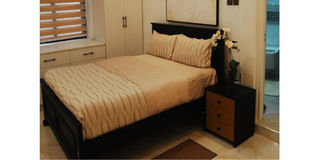Prime
Tips on making your home interior neater

According to psychologists, a neat home can improve productivity at the work place. It starts with making your bed. PHOTO | TONY MUSHOBOROZI
What you need to know:
- A well-organised and neat living space can significantly influence the productivity and well-being of its occupants, according to psychologists.
A well-organised and neat living space can significantly influence the productivity and well-being of its occupants, according to psychologists.
According to famous Canadian psychologist and author, Jordan Peterson, something as mandande as cleaning up your room can be a powerful metaphor for taking control of your life.
In many interviews he has given over the years, the professor argues that when you take the time to declutter and organize your space, you are also taking control of your thoughts and emotions, leading to a more positive outlook on life and greater success in all areas, including your daily occupation.
“Not only will you be making your life more orderly and presentable, you will also be sending a powerful message to yourself that you are in control and making positive changes,” he says.
His insistence that young people can turn around their lives by just making their beds every day may sound simplistic but is one of the things that have made Peterson an internet sensation. Having a neat home has potential to improve your life, according to psychologists.
The following tips should help on how to make your interior neater always.
Interior designers emphasise the importance of an intelligently planned layout. The arrangement of furniture, the flow of the space, and the strategic placement of elements can all contribute to a more efficient and organized atmosphere.
Considering layout and functionality in a space facilitates the possibility of having efficient storage solutions, maintaining and organised interior. Incorporation of storage options that are both practical and aesthetically pleasing can provide a motivation to be neater.
Simple innovative storage ideas
Abigail Arinda, a lead strategist and interior designer at Ideal Home Services observes that using multifunctional furniture is one way in which space can be efficiently utilised giving an attractive look to a house’s occupants.
“In bathrooms, bathroom wash basins can be used instead of a sink that comes with a lower base. This can work as a shelf where you can store things. In kitchens, people have resorted to putting simple small shelves but many instead of having one shelf with one door and everything is packed inside,” Arinda explains.
Arinda adds that with beds, instead of having “under the bed space” vacant people have chosen to filling the space with shelves that can be used to store different items.
Colours have the power to influence mood and energy levels. Interior designers often consider the psychological impact of color choices when creating a space.
Colour can be used to foster concentration, creativity, and a sense of calmness. There are bold, calm and neutral colours, bold colours give energy, while calm colours represent tranquility. Blue is known for efficiency in a workspace, yellow for creativity, green for a harmonious environment and red for active workspaces.
Furniture selection
The choice of furniture goes beyond aesthetics. Selecting furniture items does not work to only complement the design but also contribute to a well-organised space. Furniture with built-in storage, ergonomic considerations, and multifunctional designs can maximise both style and efficiency.
Arinda advises that when choosing furniture, keep in mind the space in the house so you have breathing space. Having free space and lighting makes the room beautiful.
“Have some space to move around in case you want to shift a particular item,” she says, adding that multifunctional furniture like couches can be used as beds at night, design of a TV unit can work as a book shelf and a reading table while a console table as a shoe rack,” Arinda says.
It is important to take measurements for them to correspond with the space of allocation.
Technological integration
In the age of smart homes, technology can be seamlessly integrated into interior design to enhance organisation and efficiency.
Using sensors, to sense people who enter a space can help one save the time and energy that is used in micromanaging a home as well as security rocks that can identify voices and fingerprints contributing to a streamlined and productive living environment.
Client consultations
Understanding the lifestyle and work habits of clients is a crucial step in designing spaces to promote productivity. Interior designers tailor designs to suit the unique needs of individuals.
“We do site visits to make it easy for clients to live in an effective way, we cannot make a decision online. For example a reading room or working room should have light and have natural things like planters to enhance the work mood, “says Arinda.
She undescores the importance of involving experts and technicians to save the costs that may arise from buying non-durable materials.
Why neatness
When a space is well laid out, it reduces traffic in a space and it makes the place look more beautiful. It also makes the place easy and quick to work from. For example a sitting room where the couch is facing the door instead of facing the TV brings discomfort meaning you will rotate somewhere to enter the room.
Good layout improves functionality and comfort, and helps one enjoy space without any distractions.
When designing and planning for a space, take note of how many people meant to occupy the space, how often are they going to use it, the flexibility what kind of people are going to access the space, for example when working on a bathroom and it is a kid’s bathroom, putting the mirror so high means the users are not considered.
Storage solutions improve the working mood, the space ambience is better than one a cluttered space.




